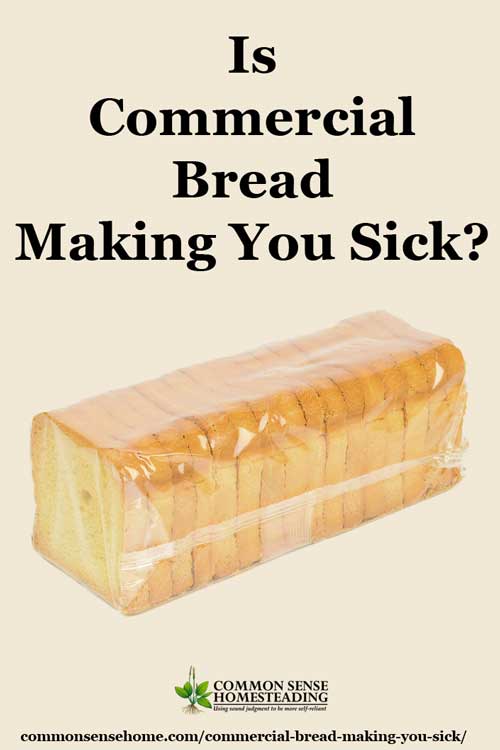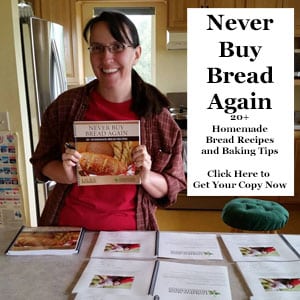Is Commercial Bread Making You Sick?
Commercial bread is designed to be durable and cheaply mass produced. As such, it often contains ingredients that I prefer to avoid. Since you’re reading this post, I assume you might be concerned about them, too. The Commercial Bread Ingredients to Avoid list is an excerpt from my new book, “Never Buy Bread Again – 20+ Homemade Bread Recipes“.

As an example, Wonder Classic White Bread has the following ingredients (from Foodfacts.com (Link Removed)):
Wheat Flour Enriched (Flour, Barley Malt, Ferrous Sulfate [Iron], Vitamin B [Niacin Vitamin B3, Thiamine Mononitrate Vitamin B1 {Thiamin Vitamin B1}, Riboflavin Vitamin B2 {Riboflavin Vitamin B2}, Folic Acid Vitamin B9]), Water, Corn Syrup High Fructose, Contains 22% or less, Wheat Gluten, Salt, Soybean Oil, Yeast, Calcium Sulfate, Vinegar, Monoglyceride, Dough Conditioners (Sodium Stearoyl Lactylate, Calcium Dioxide), Soy Flour, Diammonium Phosphate, Dicalcium Phosphate, Monocalcium Phosphate, Yeast Nutrients (Ammonium Sulfate), Calcium Propionate
Commercial Bread Ingredients I Try to Avoid
Soybean Oil and Soy Flour
Over 90% of the U.S. soybean crop is genetically modified to be glyphosate tolerant. In recent years, the MRL (maximum residue level) of glyphosate on the crops at harvest was increased 200% to accommodate increasing chemical use.
Soy may also act as an endocrine disruptor when consumed in quantity. This means it may contribute to reproductive health issues and increased cancer risks.
High Fructose Corn Syrup
Approximately 90% of the corn crop in the United States is genetically modified (GM). If you’re not buying organic, odds are that most corn containing products that you purchase will be genetically modified. It is commonly noted in online allergy discussion groups that sensitive individuals will react to genetically modified corn and corn products while at the same time being able to safely eat non-GMO corn and corn products with no adverse reactions.
In addition to potentially being more allergenic, high fructose corn syrup (HFCS) has been shown to contain mercury and other contaminants. It is also harder on the liver than cane sugar, as this excerpt from DrHyman.com explains:
Fructose goes right to the liver and triggers lipogenesis (the production of fats like triglycerides and cholesterol) this is why it is the major cause of liver damage in this country and causes a condition called “fatty liver” which affects 70 million people. The rapidly absorbed glucose triggers big spikes in insulin–our body’s major fat storage hormone. Both these features of HFCS lead to increased metabolic disturbances that drive increases in appetite, weight gain, diabetes, heart disease, cancer, dementia, and more.
Hidden Glyphosate
Most genetically modified corn is “Roundup Ready ®”, i.e., engineered to withstand glyphosate weedkiller application without dying, and contains Bt (Bacillus thuringiensis), a biological pesticide. Glyphosate residue may also be found in other ingredients. For instance, 95% of sugar beets now grown in the United States are also genetically engineered to be glyphosate tolerant. If your sugar doesn’t say “organic” or “pure cane sugar”, odds are that it’s made from GM sugar beets.
Even crops that are not Roundup Ready ® may be contaminated with glyphosate. In order to produce a more uniform dry down of plants (and potentially higher yields), some sugar cane and wheat farmers are now treating their crops with glyphosate just prior to harvest. Since it is purposely applied just prior to harvest, risk of glyphosate residue is high. If you prefer to avoid glyphosate in your food, stick to organic ingredients.
Calcium Propionate
While propionates do occur naturally in small amounts in foods such as cheese and are produced in the body as part of the digestive process, this is one of those cases where “the dose makes the poison”. Real cheese still molds – highly processed bread doesn’t mold for a very long time.
Would you like to save this?
The Australian Food Intolerance Network (AFIN) lists the following symptoms that have been linked to the consumption of propionic acid salts:
- Irritability
- Restlessness and Inattention
- Sleep disturbance
- Migraine and headaches
- Gastrointestinal symptoms such as stomach aches, irritable bowel, diarrhea
- Urinary urgency, bedwetting
- Eczema and other itchy skin rashes
- Nasal congestion (stuffy or runny nose)
- Depression, unexplained tiredness, foggy brain
- Speech delay, impairment of memory and concentration
- Tachycardia (fast heart beat)
- Arrhythmia
- Seizures
- Growing pains
- Loud voice (no volume control)
- Adult acne
There’s a very provocative statement on the AFIN website that caught my attention:
“If you wanted to create a nation of underperforming children, you could hardly do better than to add a preservative known to cause learning difficulties to an everyday staple food.”
– Sue Dengate
It makes you wonder if something so simple as commercial bread could be a major player in the increase in learning difficulties being seen in schools. I’d just as soon not have my kids be the guinea pigs in this particular experiment.

If You’re Going to Eat Bread, Stick with a Short Ingredient List
Although it’s become trendy to ditch grains completely or go gluten free, at least some studies suggest that whole grains can benefit your health. While many commercial “whole grain” or “whole wheat” breads contain mostly white flour, when you make your own bread you know exactly what’s in it.
Harvard School of Public Health notes the following on whole grains:
Most studies, including some from several different Harvard teams, show a connection between whole grains and better health.
An intriguing report from the Iowa Women’s Health Study linked whole-grain consumption with fewer deaths from non-cardiac, non-cancer causes. Compared with women who rarely or never ate whole-grain foods, those who had at least two or more servings a day were 30 percent less likely to have died from an inflammation-related condition over a 17-year period. (1)
- A meta-analysis combining results from studies conducted in the US, the United Kingdom, and Scandinavian countries (which included health information from over 786,000 individuals), found that people who ate 70 grams/day of whole grains—compared with those who ate little or no whole grains—had a 22 percent lower risk of total mortality, a 23 percent lower risk of cardiovascular disease mortality, and a 20 percent lower risk of cancer mortality. (10)
The same article also highlights studies that show whole grains may lower the risk of cardiovascular disease, type 2 diabetes, and cancer. So – if you’re going to eat bread, eat good bread, and make at least some of it whole grain.
Real Bread on a Budget
The easiest way to know for sure what’s in your bread is to make it yourself. I’m sure many of my readers are already excellent bakers, but for those who aren’t, don’t panic! If you can follow directions, you can bake. There are a number of bread recipes on the site.
In my new book “Never Buy Bread Again – 20+ Homemade Bread Recipes“, I’ve combined these recipes with a number of other family favorites, plus:
- troubleshooting tips
- how to store bread before or after baking for best quality
- recipes to make with bread
- things paired with bread (like flavored butters)
You can order your copy now in spiral bound paperback or digital (PDF, mobi and Epub). The digital version is included as a free bonus with your purchase of the spiral bound version. Get your copy here.


This is why I go Keto, Never have to worry about bread, and I usually By High Fiber -Very low-carb bread, for example, 1-4or5grams a Slice whereas a 4 inches x 4 inches 11cm x 11cm .5 inches or 1cm thick Slice of Bread is 12-17gr. of Fiber per slice, And little to No Carbs per slice. Remember Keto is the Common Sense Proper Human Diet. That we have been for the Past 1000’s of years. And low to no sugar in these High-Fiber Low Carbs Keto loaves of bread.
Hi
I want to caution you about the use of the term organically grown or the shorter version organic.
Genetically mutilated organisms GMO can be grown organically.
Growing organically means using no petrochemical-based fertilizer or petrochemical-based pesticides or chemically derived pesticides. It is a method of farming. Nothing more.
Don’t be duped.
At this time that is not correct (that may change in the future).
Specifically, from the USDA “Can GMOs Be Used in Organic Products?“:
It’s best, if possible to know your farm and farmer, and make sure they are also caring for the soil and ecosystem, but certified organic products may not be genetically modified at this time.
To be a certified organic grower you can not grow GMO plants, it is in the regulations worldwide. Anything labeled organic has to be certified organic.
Just now heard of this book, darn it. Is there any way I may obtain a copy? Thanks!
Alas, the kickstarter was a resounding flop, so I didn’t make my funding goal. I was going to self-publish, but decided to pitch to a couple of publishers. They are notoriously slow at responding (most warn it will likely be months), so I’m still waiting to hear back if they are interested. Hopefully I can get it published one way or another sometime this year. Thank you for asking!